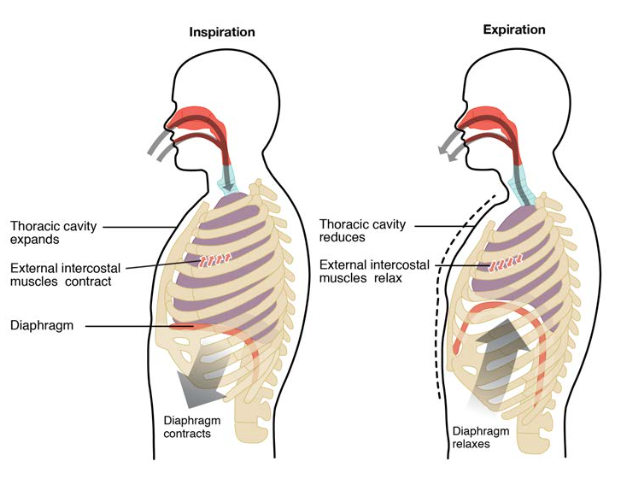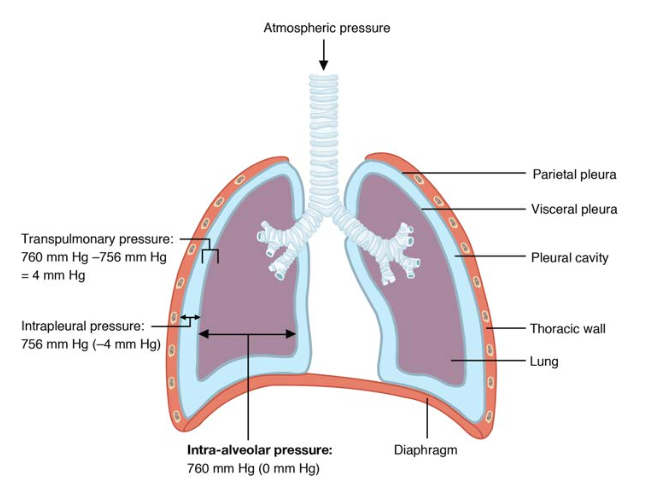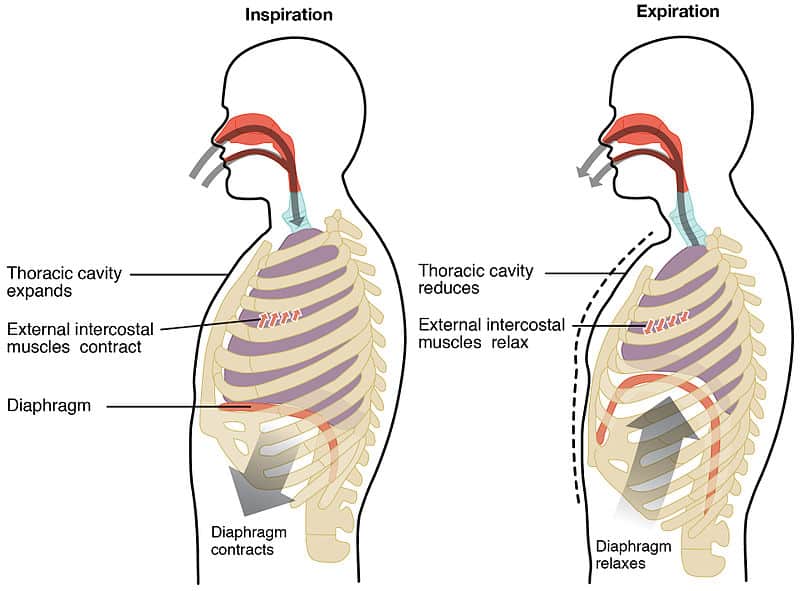Describe the Process of Pulmonary Ventilation
Pulmonary ventilation is the act of breathing which can be described as the movement of air into. The volumes measured with a spirometer should be fairly consistent throughout the life of an individual.

The Process Of Breathing Anatomy And Physiology Ii
Four Events of Respiration.

. Goals To relate Boyles law to ventilation. Pulmonary ventilation is the act of breathing which can be described as the movement of air. Once pulmonary ventilation inhaled a breathe of air has taken place and the lungs are filled with air the second stage of respiration takes place pulmonary gas exchange.
Air flows because of pressure differences between the atmosphere and the gases inside the lungs. The purpose of the respiratory system is to perform gas exchange. Inspiration which is the expansion of the chest with a negative intrapulmonary pressure when air flows into the thorax.
The process of moving air in and out of the lungs is called ________ _________. What is pulmonary ventilation. The same term may also refer to the amount of air moved in and out of the lungs in one minute.
Ventilation V refers to the flow of air into and out of the alveoli while perfusion Q refers to the flow of blood to alveolar capillaries. Describe the process of pulmonary ventilation and diffusion with reference to the relevant laws of gas exchange and flow. The respiratory process consists of three components.
Ventilation consists of two parts. An inhalation and exhalation involves changes in the lung volumeVolume change creates pressureGradients that move air in or out of respiratory tractBoyles law explain the process of pulmonary. The major mechanisms that drive pulmonary ventilation are atmospheric pressure P atm.
Anatomy of the lungs Air enters the respiratory system through the mouth and the nasal cavity passing through the pharynx then larynx where sounds are produced for speech and finally the trachea which enters the chest cavity. It involves two events. 11 rows Pulmonary ventilation is the act of breathing which can be described as the movement of air.
It is a mechanical process that depends on volume changes in the chest cavity. Pulmonary gas exchange takes place in the lungs between the alveoli and the blood. Gas exchange occurs in the lungs between alveolar air and the blood of the pulmonary capillaries.
Breathing Process of moving air into and out of the lungs to change and refresh gas in the lungs. Ventilation is the rate at which gas enters or leaves the lung. Respiratory Rate and Control of Ventilation.
The three types of ventilation are minute ventilation alveolar ventilation and dead space ventilation. Air moves into lungs when pressure inside lungs is less than atmospheric pressure air moves out of lungs when pressure inside lungs is greater than atmospheric pressure. Breathing usually occurs without thought although at times you can.
To identify the muscles used during ventilation. In the medical world breathing is defined as pulmonary ventilation described as the movement of air between the atmosphere and the lung alveoli. Pulmonary ventilation is commonly referred to as breathing.
Pulmonary ventilation is the act of breathing which can be described as the movement of air into and out of the lungs. Pulmonary ventilation is the act of breathing which can be described as the movement of air. As air moves into and out of the lungs it travels from regions of high air pressure to regions of low air pressure Page 2.
Breathing or pulmonary ventilation has two phases - inspiration or inhalation and expiration or exhalation. The volume changes result in pressure changes which lead to the flow of gases to equalise the pressure. It is the process of air flowing into the lungs during inspiration inhalation and out of the lungs during expiration exhalation.
Ventilation diffusion and perfusion. As air moves into and out of the lungs it travels from regions of high air pressure to regions of low air pressure. The air pressure within the alveoli called intra-alveolar pressure P alv.
Process of exchanging gas O2 and CO2 between blood and alveoli. Pulmonary ventilation provides air to the alveoli for this gas exchange process. Pulmonary ventilation commonly known as breathing is the process of moving air into and out of the lungs.
At the respiratory membrane where the alveolar and capillary walls meet gases move across the membranes with oxygen entering the bloodstream and carbon dioxide exiting. Pulmonary ventilation or breathing is the exchange of air between the atmosphere and the lungs. Refer to the following laws.
And the pressure within the pleural cavity called intrapleural pressure P ip. For effective gas exchange to occur alveoli must be ventilated and perfused. Breathing is one of the four components of respiration the other three being gas diffusion gas.
Pulmonary ventilation or breathing is the exchange of air between the atmosphere and the lungs. Pulmonary ventilation is the process of air flowing into the lungs during inspiration inhalation and out of the lungs during expiration exhalation. The Processes of the Respiratory System Pulmonary Ventilation.
Air flows because of pressure differences between the atmosphere and the gases inside the lungs. The alveolar ventilation rate changes according to the frequency of breath tidal volume and amount of dead space. Comment on how ventilation andor diffusion may be affected by emphysema.
Inspiration when the air moves into the lungs and expiration when the air leaves the lungs.

Pulmonary Ventilation Pulmonary Ventilation Or Breathing Is The Exchange Of Air Between The Atmosphere And The Lungs As Air Moves Into Inspiration Ppt Download

The Process Of Breathing Anatomy And Physiology Ii

Mechanics Of Breathing Inspiration Expiration Teachmephysiology

0 Response to "Describe the Process of Pulmonary Ventilation"
Post a Comment